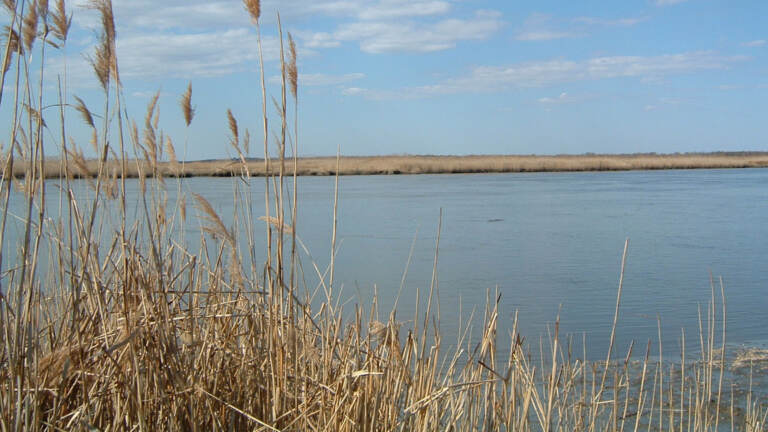‘Huge leap forward’ for preservation of Delaware Bay wetlands
Multiple projects are coming together to protect a key habitat for the Cumberland County oyster fleet from erosion and rising seas.

The Maurice River in New Jersey. (Flicker/Asturnut)
This story originally appeared on NJ Spotlight.
The historic oyster fleet of Bivalve, located at the mouth of Cumberland County’s Maurice River, is one step closer to gaining better protection from the onslaught of rising water and eroding marshland.
Last year, a team led by the Highlands-based American Littoral Society was awarded $4.8 million in federal funds for the planning of a $12-million project that would see the construction of a rock revetment and breakwaters, along with oyster reefs, mussel beds, and other natural barriers, in areas around the mouth of the Maurice that have severely eroded in recent years.
That left team members on the hunt for another $7 million, which they were hoping to obtain through a state match. This month, they received word that they were halfway there: The state, tapping the recently passed budget, has earmarked $3.2 million in matching funds for the project. The allocation will allow for contract bidding and awarding, as well as the first phase of construction, to begin.
“That’s obviously a huge leap forward,” said Tim Dillingham, the Littoral Society’s executive director. “We have all the required state and federal permits in place, and now we have funding to allow us to get going.”
The project will address in three phases several endangered areas at the river’s mouth. The first priority is the critically eroded Basket Flats, a peninsula of salt marsh that extends from the mouth’s western shore and protects the oyster docks at Bivalve and Matts Landing from the waves and currents of the open bay. Since 1985, Basket Flats has been winnowed by over a quarter mile, virtually eliminating an entire reach — or bend — in the river.
The erasure of Basket Flats has also caused an increase in the amount and frequency of wave energy hitting Northwest Reach, on the opposite shore, resulting in a half-mile-wide swath of shallow, open water where there were once healthy tidal wetlands.
Initial phases
Basket Flats will be addressed in the first phases of the project, which Dillingham expects to kick off early next year.
An approximately 8-foot-high, 400-foot-long rock revetment will be constructed at the head of the Basket Flats peninsula, curving to match the shoreline’s westward bend. On the bay side, nine 200-foot-long rock breakwaters will stand guard against the open water just offshore and be fortified by sub- and intertidal oyster reefs. Along the shoreline, mussel beds and Spartina alterniflora grass will be planted, which can help the marshland grow at a faster rate.
The final phase addresses Northwest Reach, where 18 breakwaters of about the same length as those at Basket Flats will be built to reduce the erosive currents of the open bay. This area will also have oyster reefs and shoreline areas planted with mussel beds and Spartina alterniflora.
Aside from stopping work during the spring and early summer for the annual shorebird migration and horseshoe crab spawn, the work will continue until early 2023, when Dillingham estimates the first phases of the project will be complete.
In addition to the $12 million in restoration work slated for Basket Flats and Northwest Reach, the Littoral Society is hoping that additional funding can be found to help shore up the rapidly disappearing eastern mouth of the river, where historic East Point Lighthouse, the second oldest light in New Jersey, sits perilously close to the water’s edge.
For years, the state has embarked on shoreline-hardening projects at East Point that have fallen short, in terms of slowing the erosion of the narrow beach that stands between the lighthouse and the bay. Here too, some combination of breakwaters, rock revetments and living shoreline could be constructed to better protect the lighthouse.
“Just like Bivalve, East Point is an irreplaceable, historic resource, and it’s vulnerable and being worn away,” Dillingham told NJ Spotlight News earlier this year. “Something needs to be done.”
Dredging project also seen as a help
Also on tap is shoreline replenishment with materials dredged from the Maurice River’s channel, thanks to a separate project by the state’s divisions of Fish & Wildlife and Coastal Engineering, and the Army Corps of Engineers, that’s part of President Joe Biden’s budget for the 2022 fiscal year.
While entirely distinct from the Littoral Society’s work, the $4-million dredging project would provide another substantial boost of protection for a waterway and marine ecosystem that has historically been neglected by the state and federal governments.
The Maurice River channel has not been dredged since the 1990s, and shoaling there has become a hazard, especially for the larger boats that make up the Bivalve oyster fleet. In its entirety, the project aims to create a 7-feet-deep (from mean low water), 150-feet-wide channel across the mouth of the river. (Additional survey data of the area will be processed by the end of this month, at which point the project partners will meet with local stakeholders to determine and define the most optimal dredging locations.)
The difference between this dredging effort and those of the past is the Corps and New Jersey Department of Environmental Protection’s philosophy on the use of the materials removed from the seafloor. In the past, channel sediments — which in southern New Jersey’s back-bay waters tend to consist of a mixture of fine-grained materials with some sands — were considered unusable and transported to confined disposal facilities located offsite.
New philosophy in play
In recent years, however, the state and Corps have been experimenting with using these materials to redistribute on eroding shorelines and marshland adjacent to dredging projects. At test sites in nearby Cape May County, the Corps, the state and local partner The Wetlands Institute have been successful in building up marshland and mudflats by “sediment enhancement,” a technique that utilizes a spray nozzle to gradually distribute fine coats of dredge material to raise land while at the same time minimizing impacts to existing vegetation.
“The ultimate goal is not for some of these projects to be big construction projects, but nourishing efforts, like fertilizing your garden,” said Monica Chasten, a project manager in the Corps Operations Division who is leading the agency’s work at both the Cape May County test sites and the Maurice River. “So, we might be able to come through and spray a little bit of fine-grained material, throwing it back where it came from.”
Once the initial dredging is complete, Chasten said, the hope is that the Corps will return regularly to do smaller-scale maintenance dredging as well as sediment enhancement — a long-term effort that would both keep the channel deep and provide consistent renourishment of critical shorelines like Northwest Reach and other vulnerable marshland areas nearby.
At this point, the dredging work must clear a series of federal regulatory hurdles, so it won’t get started until sometime after the Littoral Society’s project. But both Chasten and Dillingham agree that the combined efforts point toward a new era for the once-forgotten Bayshore, especially the Maurice River and its oyster fleet in Bivalve.
“Whatever we’re learning on any of these projects,” Chasten said, “we’re all sharing as a community.”
Dillingham agreed. “We have to find better ways to do adaptation,” he said. “And I think that these projects, because they are larger in scale, will give us a chance to prove that it can be done, and that it can be done collaboratively.”
WHYY is your source for fact-based, in-depth journalism and information. As a nonprofit organization, we rely on financial support from readers like you. Please give today.






